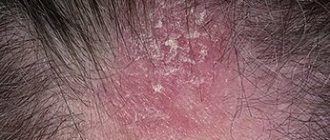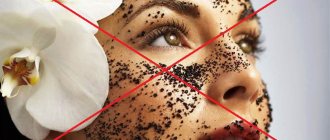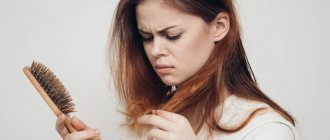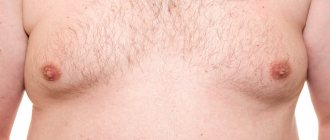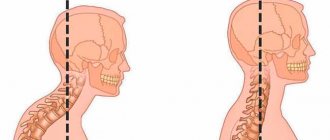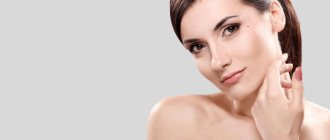Seborrheic dermatitis on the face photo
Photo 1. Seborrheic dermatitis on the face of an adult
Photo 2. Seborrheic dermatitis on the face of an adult
Photo 3. Seborrheic dermatitis
Photo 4. Seborrheic dermatitis on a child’s face
Causes of seborrheic dermatitis on the face
The main cause of seborrheic dermatitis is the increased functioning of the sebaceous glands and a change in the composition of the fat they produce. A similar situation develops when the Malassezia fungus multiplies excessively (normally it is part of the skin microflora). In this case, it penetrates the sebaceous glands and produces a special secretion that forces subcutaneous fat to break down, forming fatty acids that irritate the skin and contribute to the occurrence of rashes.
Dermatitis affects men more often than women, which is explained by the action of androgen, a male hormone. This hormone stimulates the synthesis of subcutaneous sebum. In women, the disease usually manifests itself when estrogen levels decrease and androgen concentrations increase.
Seborrheic dermatitis on the forehead is especially often diagnosed in people whose close relatives have a similar problem, which is associated with a hereditary predisposition.
Other factors can also provoke the development of the disease:
- hormonal imbalances;
- disruption of the endocrine system (especially the thyroid gland);
- weakened immunity;
- hypovitaminosis;
- unfavorable environmental situation;
- improper facial skin care;
- excessive sweating;
- poor nutrition;
- lack of sleep;
- uncontrolled use of medications, especially hormonal ones;
- exacerbation of chronic diseases;
- presence of infection in the body;
- dysfunction of the nervous system, manifested in the form of epilepsy or schizophrenia;
- diabetes;
- pathologies of the gastrointestinal tract;
- frequent stressful situations;
- overwork;
- malignant tumors in the adrenal glands or genitals.
Skin hydration
There are several ways to get rid of flaking on your face. Initially, it is necessary to determine the causes of the problem. In the case of an allergic reaction, exposure to allergens should be eliminated by purifying the air or replacing cosmetic products. In winter, switch to using products with a high fat content that can withstand low temperatures. Optimize your diet based on the amount of water you consume. You need to drink at least 1.5 liters of purified drinking water per day to maintain your water balance.
Pay attention to cleansing and moisturizing your face, especially after a day of work. Sweat, dust and other impurities that come into contact with the face negatively affect the overall condition of the skin. Use specialized gels and lotions to cleanse your face. This kind of procedure is carried out twice a day. Don’t forget about vitamins, vitamin D3, regulates calcium-phosphorus metabolism, and vitamin complexes, as a rule, contain B vitamins, vitamins A, C, folic acid and Omega-3, they will help compensate for the lack of vitamins in the body. Take care of your own skin, take care of it, and you will look great for many years.
Symptoms of seborrheic dermatitis on the face
With seborrheic dermatitis on the face, symptoms appear:
- the appearance of pink, red or burgundy spots on the skin;
- the formation of white or yellowish scales and hemorrhagic crusts;
- peeling of the skin;
- irritation and increased sensitivity of the skin;
- itching and burning of varying intensity.
The course of the disease worsens in the autumn. In summer, unpleasant symptoms usually disappear.
If the ducts of the sebaceous glands become clogged, acne appears.
The disease is especially severe in men who grow beards and mustaches. Large plaques form under the hairline, which eventually transform into papules. If an infection occurs, then erythroderma is also detected. When papules coalesce, swollen areas colored red form.
The symptoms of seborrheic dermatitis are similar to those of other dermatological diseases. Therefore, only a doctor can make a correct diagnosis after a thorough examination of the patient.
How to treat seborrheic dermatitis on the face?
If symptoms of seborrheic dermatitis appear on the face, treatment should be carried out by a specialist. Self-medication can only worsen the condition.
The dermatologist will examine the patient’s skin and refer it for laboratory testing. If necessary, he will advise you to consult a neurologist, endocrinologist, gastroenterologist, andrologist or gynecologist. Based on the diagnostic results, the doctor will select the optimal treatment, which should be comprehensive. First, the dermatologist prescribes weak drugs. If they do not produce the desired result, then he moves on to potent ones.
To effectively cope with the disease, it is imperative to identify and eliminate the cause of the disease. If dermatological problems are caused by disturbances in the digestive system, the patient is referred to a gastroenterologist. After the examination, he will prescribe suitable medications, most often enzymes, sorbents and choleretic agents. Enzymes and choleretic drugs will restore the functioning of the gastrointestinal tract, and sorbents will remove toxic substances from the body.
Typically, treatment for nasal dermatitis includes:
- compliance with the diet prescribed by a specialist;
- drug therapy;
- physiotherapy;
- maintaining personal hygiene using gentle products.
Drug therapy involves taking:
- antihistamines - relieve itching;
- probiotics – restore intestinal microflora and normalize the functioning of the digestive tract;
- vitamin complexes – strengthen the immune system and increase the body’s resistance.
In addition to medications intended for oral use, external agents that have a moisturizing, anti-inflammatory and antifungal effect are recommended.
Both glucocorticosteroid hormonal ointments and non-hormonal drugs can be used. But you need to know that glucocorticosteroids, although they have an effective effect (relieve inflammation, swelling and redness), but they are addictive and, with prolonged use, provoke side effects (vasodilatation, the formation of rosacea and telangiectasia, the development of erythema).
Therefore, it is better to give preference to non-hormonal drugs, among which the products of the “Losterin” series (cream, ointment, gel, shampoo) have shown particular effectiveness. They are characterized by a neutral composition, do not contain hormones, do not irritate the skin and are not addictive. The drugs included in the “Losterin” line can be used not only by adults, but also by newborn babies. They are recommended for daily use both during remission and during acute inflammation. Active substances (naphthalan, salicylic acid, natural oils, medicinal plant extracts) are included in the composition of “Losterin” products in optimal proportions, which determines the most effective therapeutic effect. Even if seborrheic dermatitis has passed, Losterin should continue to be used to prevent a relapse.
Physiotherapeutic procedures can effectively complement drug treatment. Small doses of ultraviolet light will ease the course of the disease, restore the functioning of the sebaceous glands, and relieve redness, swelling and itching.
Peeling of the scalp
Signs of peeling skin are redness of certain areas, pain when touched, and a feeling of constant or periodic itching. Cracks often appear. The skin becomes rough to the touch and loses its usual smoothness and elasticity.
As practice shows, flaking of the scalp can be possible without itching. Itching is the neglect of the scalp peeling process. In order to get rid of peeling, especially obsessive itching, we need to treat our skin and use special medicinal and cosmetic products.
Causes of peeling skin
One of the first on the list of factors influencing skin condition is the environment. Although often flaking of the skin can be caused by serious skin diseases, which are quite common, for example, psoriasis. This disease is provoked by a fungus, which promotes the rapid death of skin cells, as a result of which they become keratinized and promote peeling. So, in this case, you need to fight not with the cosmetic defect itself, but with the problem that caused its appearance.
Often the scalp flakes due to chronic fatigue and a large number of stressful situations. Sometimes it is enough just to take care of the nervous system, and the condition of the skin will return to normal. We can also include unhealthy diet in this category. Indeed, if the body lacks vitamins and nutrients, flaking may occur along with other problems associated with vitamin deficiency. There is only one way out - to pay close attention to your diet.
Also causes of flaking of the scalp can be:
Dry skin caused by frequent washing with a product that is harsh on the skin.
Allergic reaction to cosmetic products for styling and washing hair. In this case, not only flaking of the scalp occurs, but also itching.
Dandruff caused by a fungus. Most often, this disease is accompanied by the formation of small scales, but in rare cases they can be large, which is why dandruff is mistaken for normal flaking.
People with dry skin are more likely to experience flaking.
Most often, flaking of the scalp is observed in those with dry skin, but there are exceptions. If you still have a dry skin type, you can try using special masks that will correct your skin type towards normal. You can use special creams and lotions for the head. They are quite easy to use, so it is quite easy to do this procedure at home.
As for peeling in infants, in this case there is no need to rush to prescribe treatment. Peeling of the scalp is a completely natural process for a newborn, which can be caused by renewal of the epidermis. It’s a completely different matter if your child constantly experiences discomfort and the skin is peeling all the time. In this case, you should immediately contact a specialist and begin treatment.
Peeling scalp - treatment
Today, there are various remedies that help get rid of flaking scalp. However, during treatment it is very important to determine the cause and eliminate it, since otherwise peeling will occur again, regardless of how effective the remedies used are.
Perhaps you just need to change the shampoo to one that suits your skin more correctly and the problem will go away by itself. Or you may need to see a specialist to treat a disease such as psoriasis.
Don't forget that the top brands on the planet are trying to give us an effective way to overcome flaking scalp. The best example of this is the Med-Planta antiseborrheic complex of drugs.
Antiseborrheic complex of drugs Med-Planta
It concentrates all the experience of the specialists of this brand.
So, effective ways to eliminate flaking of the scalp are as follows:
- Replace your regular shampoo with a specialized anti-dandruff analogue. The shampoo should be truly therapeutic, and not just a highly advertised product, as is most often the case. In addition, avoid various means of fixing your hairstyle for a certain period - they greatly dry out the skin, thereby causing it to peel.
- Completely cleanse your body of all kinds of toxins - flaking of the scalp can be a manifestation of general toxic pollution. To do this, it is best to temporarily go on a diet rich in fortified foods, in which alcoholic and tonic drinks, confectionery, fatty foods, etc. are prohibited. It is also very important to exercise so that your body naturally receives the necessary energy and directs it towards overall health.
- Use special lotions based on medicinal herbs - this will help soothe the tissues, gradually relieve inflammation and normalize the process of secretion of the sebaceous glands.
- Monitor the air humidity in the room where you spend the most time: office, home, etc. You also need to avoid sudden changes in temperature, as they greatly affect the flaking of the scalp.
Of course, all these methods should be used at your own discretion only if you are sure that your itching and flaking of the scalp are not caused by any infectious fungal diseases or other serious ailments of the body. Otherwise, the most correct decision would be to immediately consult a dermatologist who will prescribe you an individual course of treatment.
Take care of your health.
Prevention of seborrheic dermatitis on the face
To prevent dermatitis on the forehead from causing a relapse, it is recommended to follow several rules:
- strengthen the immune system;
- cleanse the body of waste and toxins;
- exclude from the diet salty and spicy foods, fatty and smoked foods, marinades, spices and condiments, sweets, chips and crackers, products containing preservatives, flavor enhancers and dyes;
- introduce fermented milk products into the menu, which include lacto- and bifidobacteria, animal proteins, bran, buckwheat, oatmeal;
- cook food with vegetable oil;
- restore the functioning of the digestive system.
How to get rid of dry skin
If the skin near the nose, forehead, cheeks, or chin is peeling, an integrated approach is needed. It is important to eliminate the cause and restore hydrobalance, as well as to properly care for the dermis in the future.
You can revive your skin at home using store-bought medications and folk remedies.
Subtleties of skin care
Dry skin is often the fault of the woman herself, who did not take care of her face properly. It is necessary to provide complete care. To do this, just follow these rules:
- select care products suitable for your skin type;
- wash your face 1-2 times a day, using milk or gel for washing (alkaline soap is prohibited);
- use high-quality decorative cosmetics, if possible hypoallergenic;
- do not use aggressive products for whitening or removing oily shine;
- use sunscreen.
In addition to proper care, a balanced diet is important. This is the main condition for the health and youth of the dermis. The greatest benefit will come from foods high in omega-3 and vitamins E and A. These include seafood, nuts, carrots, and vegetable oils. If the diet does not contain enough vitamins, you can take multivitamin complexes.
If you are prone to allergic reactions, it is necessary to exclude allergenic foods from your diet.
It is important to maintain favorable climatic conditions in the apartment. Air humidity is not lower than 50%, temperature is 21-23 ˚С.
Preparations for the treatment of peeling skin
The choice of remedies to eliminate dryness depends on the cause. If peeling is caused by seborrheic dermatitis or other fungal diseases, you cannot do without antifungal agents. Treatment should last at least a week.
In case of increased dryness, it is necessary to use moisturizing creams and avoid alcohol-based products. Ideally moisturizes almond, peach, olive oils. If you are predisposed to allergies, you can use Panthenol, Solcoseryl.
Preparations with hyaluronic acid do an excellent job of treating dryness, especially if taken orally. But even serums or ointments will give an effect.
